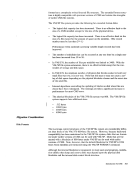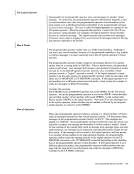Migration Considerations
Disk Formats
format has a completely revised internal file structure. The extended format struc
ture is highly compatible with previous versions ofeMS and retains the strengths
of earliereMS file systems.
TheVM!SP file system provides the following for extended format disks:
The logical disk capacity has been increased. There is no effective limit to the
size of aeMS minidisk except for the size of the physical device.
The logical file capacity has been increased. There is no effective limit on the
size of a file except for the amount of space on the minidisk. (The record
number must be less than 2
31
_1.)
Performance when randomly accessing variable length records has been
improved.
The number of minidisks that can be accessed at anyone time by a single user
has been increased from10 to 26.
InVM/370, the number of files per minidisk was limited to 3400. With the VM/SP file system extensions, there is no effective limit except for the con
straints of storage and disk space.
InVM/370, the minimum number of physical disk blocks needed to hold very
small files was two; it is now one. Note that this mayor may not cause a sav
ing of disk space depending on the physical blocksize chosen and the exact size
of the small file.
Internal algorithms controlling the updating of blocks on disk when files are
closed have been redesigned. The redesign provides a significant increase in
performance for mosteMS users.
The physical blocksize of theVM/370 file system was 800. The VM/SP file system supports four additional sizes:
512 bytes1024 bytes 2048 bytes 4096 bytes
The in-storage control structures of theVM/SP file system are considerably differ
ent than those of theVM/370 800-byte file system. However, because backward
compatibility has been maintained in theVM/SP file system, disks that are format
ted under earlier versions ofeMS can be used with VM/SP. Disks that are for
matted with a blocksize of800-bytes under VM/SP can be used with earlier
versions ofeMS. Note, however, that the default blocksize for VM/SP is 1024 bytes when minidisks are formatted using the VM/SP FORMAT command.
Although the internal block size is transparent to most users and programs, installa
tion utilities that dump and restore disks may depend upon the physical disk
blocksize and the internal disk control block structure.
Introduction ToeMS 305
Disk Formats
format has a completely revised internal file structure. The extended format struc
ture is highly compatible with previous versions of
of earlier
The
The logical disk capacity has been increased. There is no effective limit to the
size of a
The logical file capacity has been increased. There is no effective limit on the
size of a file except for the amount of space on the minidisk. (The record
number must be less than 2
31
_1.)
Performance when randomly accessing variable length records has been
improved.
The number of minidisks that can be accessed at anyone time by a single user
has been increased from
In
straints of storage and disk space.
In
small files was two; it is now one. Note that this mayor may not cause a sav
ing of disk space depending on the physical blocksize chosen and the exact size
of the small file.
Internal algorithms controlling the updating of blocks on disk when files are
closed have been redesigned. The redesign provides a significant increase in
performance for most
The physical blocksize of the
512 bytes
The in-storage control structures of the
ent than those of the
compatibility has been maintained in the
ted under earlier versions of
matted with a blocksize of
versions of
Although the internal block size is transparent to most users and programs, installa
tion utilities that dump and restore disks may depend upon the physical disk
blocksize and the internal disk control block structure.
Introduction To



































































































































































































































































































































































































































































































































































































































